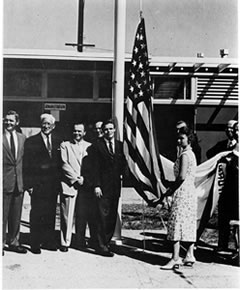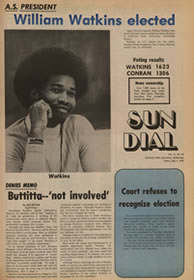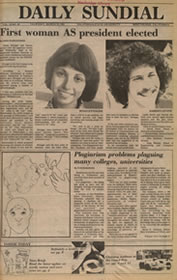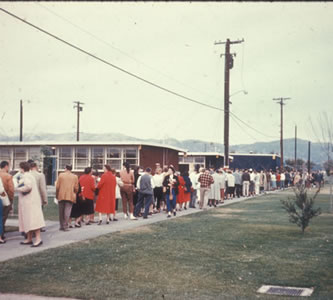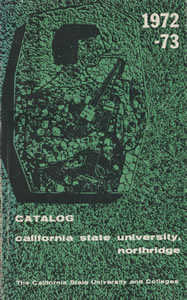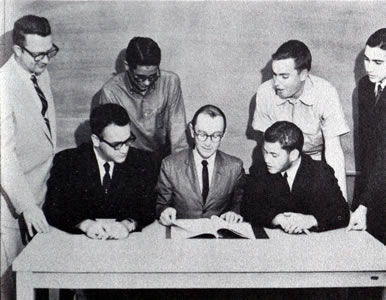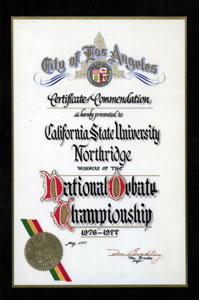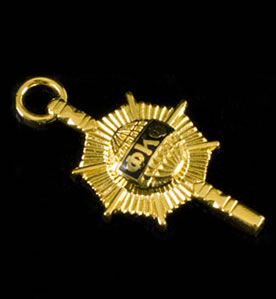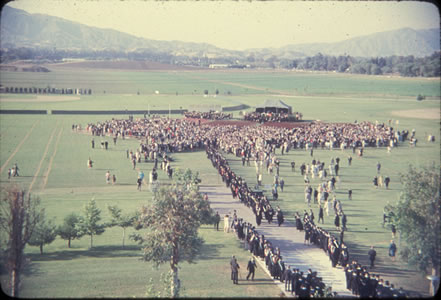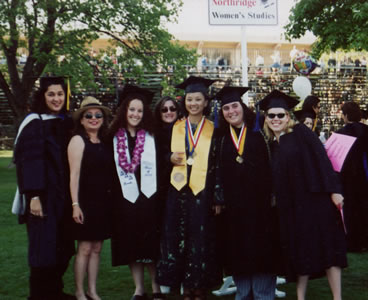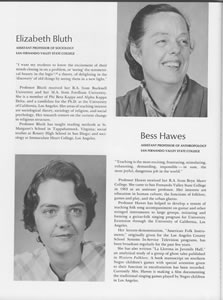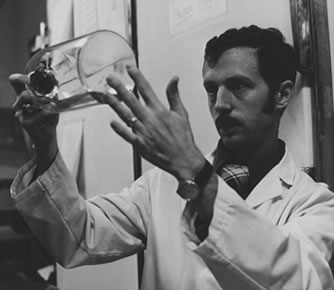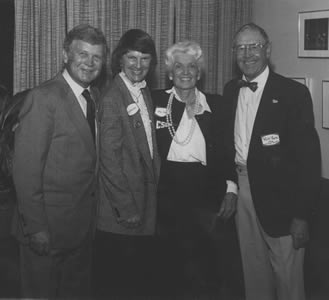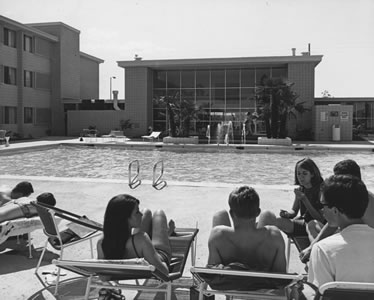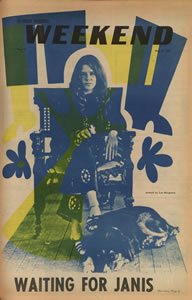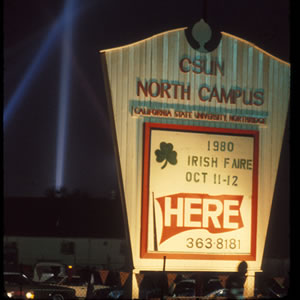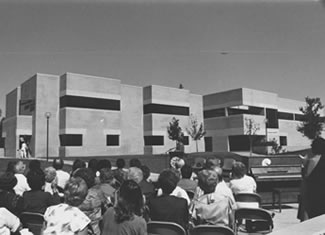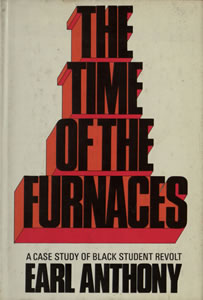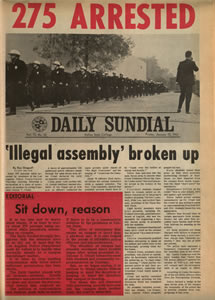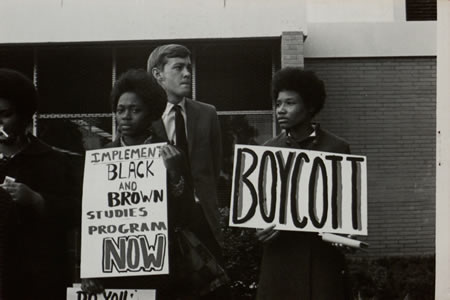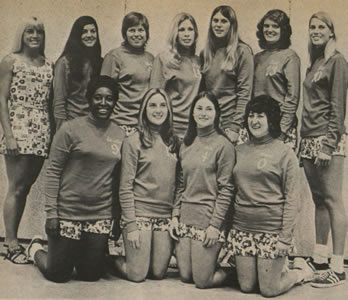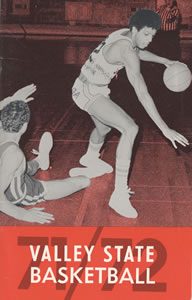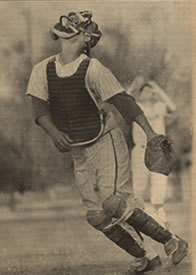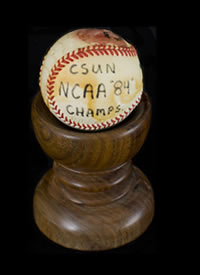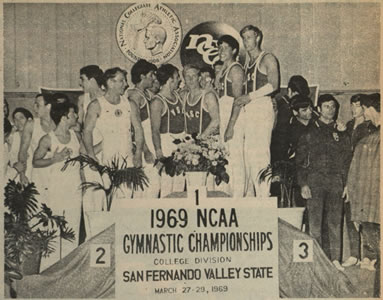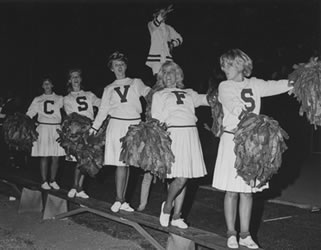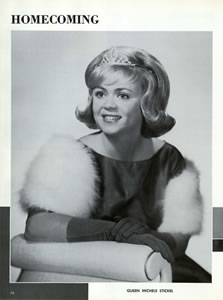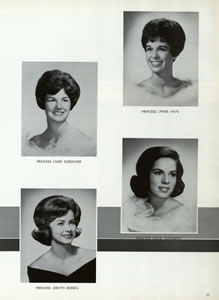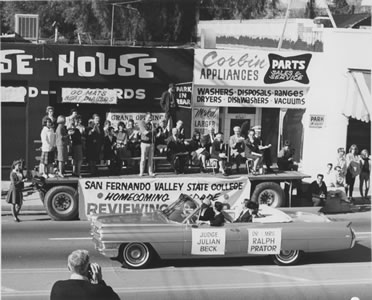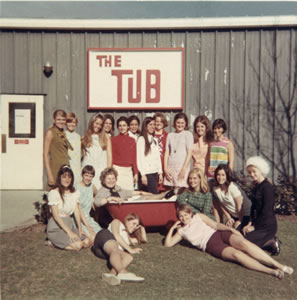Campus Life
The San Fernando Valley branch of Los Angeles State opened in 1956 with fewer than 1500 students, but within its first year the critical foundations of a student community had been laid: a student-run newspaper, Student Council, and a competitive athletics program. The first year, students socialized at the Temporary Student Union Building dubbed "The Tub."
During the 1960s San Fernando Valley State saw a wave of political activism to promote equal opportunities in higher education, to protest racism, to denounce the Vietnam Conflict, and to support California farm workers. The unrest spanning 1968-69 resulted in negotiations between student groups, the administration, and the Faculty Senate that ultimately led to the establishment of programs in Afro-American and Mexican-American studies (precursors to the Pan African and Chicana and Chicano Studies departments, respectively).
Associated Students
When the San Fernando Valley campus of LASC opened for the Fall semester in 1956, students and administrators joined to raise the flag over the new campus. Pictured is Howard McDonald, President of Los Angeles State College (far left) and Ben Rude, first President of the Associated Students (center). Rude would later serve as the first Alumni Association president.
The Associated Students began publishing the campus newspaper in February 1957, welcoming students to the first Spring Semester. The newspaper held a contest to determine its name, promising "something useful like a full grown alligator, bowl of pet piranha, '27 Cadillac convertible, used cuff links" to the winner. It was not until publication of the third issue that the paper was given its name - The San Fernando Valley Campus State Standard. One month later in the fifth issue the name would change to the State Sundial.
Ben Rude was the first president of Associated Students. William Watkins would be elected by the student body as the first African-American president in 1973 in a highly controversial election. It would not be until 1981, twenty-five years after Rude was head of student government, that Susan Ettinger would be elected as the first woman president of AS. Initially, women students organized a separate affiliated group - Associated Women Students - in charge of homecoming and special student events.
More about Student Publications
Academics
REGISTRATION WEEK
Students have had to contend with long registration and bookstore lines since the first day the campus opened. Today, registration is done on-line but the bookstore continues to be a navigational adventure as it tries to accommodate nearly 36,000 students. With the advent of improved security, students are no longer asked to leave their books on the walkway while shopping inside the store.
The 1972-73 Catalog of Classes was the first following the campus's name change from San Fernando Valley State College to California State University, Northridge in 1972. The undergraduate and graduate catalog is the primary source of information regarding campus procedures, departmental contacts, degree requirements, and course descriptions.
The first national championship won by San Fernando Valley State College was in Forensics. The team consisted of (front row L to R): Mike McGrath, Dr. Fred McMahon (Advisor), Paul Newman; (back row L to R): Paul Treat, Bob Georgius, Fred Estriem, Glen Collier.
CSUN students were winners of the National Debate Championships for 1976-1977 and were awarded a commendation from the City of Los Angeles, May 1977.
More about CSUN Forensics
PHI KAPPA PHI
The Honor Society of Phi Kappa Phi was founded in 1897 at the University of Maine. In 1900, the Society was transformed into a national honor society by action of a committee composed of the presidents of the University of Maine, the University of Tennessee, and Pennsylvania State College.
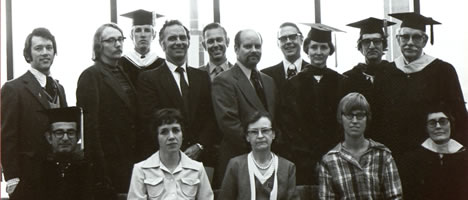
Phi Kappa Phi Chapter 163 at CSUN was chartered on May 3, 1974. Founding members were (front row L to R): Allan Gutstudt (Public Relations), Kathleen Bindert, Virginia Sherman, Nancy Owens, Charlotta Oyer (Secretary); (back row L to R): Barret Elcano, Richard O'Connell, Norman Tanis (President-Elect), Edmund Peckham, Jim Dole, Charles Sanders, LeRoy Nyquist, Daisy Kuhn (First President), Kenneth Wilson (Treasurer). Also pictured: John Butler, National Vice-President of Phi Kappa Phi.
GRADUATION
At the first commencement there were 90 graduating students and the exercises were held on the football field.
Explore SFVSC/CSUN Commencement Ceremonies

CAP AND GOWN WITH MACE BELONGING TO LIBRARY DEAN SUSAN CURZON
Elizabeth Bluth, Associate Professor of Sociology, and Bess Hawes, Associate Professor of Anthropology were among those Honored with Distinguished Teaching Awards in 1968 by the California State Colleges. The Distinguished Teaching Awards were first awarded for the 1965-1966 academic year. Dr. Hawes went on to be founder and first director of the National Endowment for the Arts' Folk Arts Program and was awarded the National Medal of Arts by President Bill Clinton in 1993.
Beginning his teaching career at San Fernando Valley State College (now CSUN) in 1971, Dr. Steven Oppenheimer has become one of the University's most prolific publishing researchers with more than 150 published articles, abstracts, and books, many co-authored with students. The Center for Cancer and Developmental Biology, of which Dr. Oppenheimer is Director, has garnered significant funding from organizations such as the National Institutes of Health (NIH) and the National Science Foundation (NSF). Here, he is shown in his lab, examining cell cultures.
Dr. William "Del" Stelck and his wife, Betsy, pose for a picture with the University's first President, Dr. Ralph Prator, and his wife, Lois. Dr. Stelck was among the first faculty members hired by the college in 1956, as a Professor of History. Dr. Stelck retired in 1987. This picture was taken during the University's 25th Anniversary celebration in 1983.
More about SFVSC/CSUN Faculty
Student Life
NORTHRIDGE HALL
The first co-ed student dormitory on campus was Northridge Hall, which opened in 1967 on Zelzah Avenue. Facilities included a self-service beauty salon, a gymnasium, a dining hall, and a study room.
More about Student Housing
In 1968, Big Brother and the Holding Company with lead singer Janis Joplin came to San Fernando Valley State College to perform in the gymnasium. A small article was written in the Daily Sundial about the band. At this point in time, Janis had been with Big Brother and the Holding Company for almost two years before going on her own. "Many consider Janis as one of the best white blues singers around, and she promises more to come."
Devonshire Downs was originally part of the 51st Agricultural District until purchased by the university. In 1967, the Devonshire Downs acreage formally became part of the San Fernando Valley State College. Also known as "North Campus," the downs was the site of many concerts and festivals, including the Newport Jazz Festival.
The Klotz Student Health Center is named after Addie L. Klotz, MD (1927-1979). "During her eighteen-year career at CSUN (1959-1977), Dr. Klotz worked closely with the University as a physician and lecturer. She was appointed Director of Health Services from 1961 to 1972. Under her direction, the CSUN Health Center was the first such program in the nation to be accredited by the American College Health Association. It was also under her direction that the new Student Health Center building was planned and constructed." [Courtesy of Klotz Student Health Center]
Campus Unrest
As student movements grew on campuses throughout the United States, university administrators and faculty faced increasing tension brought on by the Civil Rights Movement and the Vietnam Conflict. Valley State was no different. Members of the Black Student Union, United Mexican American Students and Students for a Democratic Society were pressing for increased enrollment of minority students, demanding more classes on issues important to the minority community, and an end to the war in Vietnam.
The holdings of the University Archives extensively document the viewpoints of administrators, faculty, students and the larger community during this period of political and social upheaval. Documents and photographs highlight the demonstrations, battles with the LAPD, negotiations with campus administration, and the demands and opposing views of SFVSC student groups.
THE TIME OF THE FURNACES: A CASE STUDY OF BLACK STUDENT REVOLT. By Earl Anthony. New York: Dial Press, 1971. On November 4, 1968, a group of black athletes and Black Student Union activists at SFVSC seized the sixth floor of the Administration Building, seeking demands for educational reform and an end to perceived racism in the Athletic Department. "In almost every respect, the revolt at Valley State parallels the black student revolts at other white-dominated educational institutions." Anthony documents one of the major events that exploded at Valley State, which divided students, faculty and administrators into opposing camps. [Courtesy of Special Collections, Oviatt Library - LD729 .C966 A85]
Flier announcing the first meeting of a new Valley State anti-war group, as yet unnamed. The group was interested in discussing the invasion of Laos, and what they termed a genocide in Vietnam.
The Daily Sundial loudly proclaims "275 Arrested." Those arrested were gathered at the "Open Forum," an area near the cafeteria building set aside as a place where the campus community could congregate and speak freely. On this occasion, Delmar T. Oviatt, acting President of the college, declared a state of emergency on campus and cancelled all gatherings, fearing an outbreak of violence. Among those arrested were eight faculty members and the campus minister. All were charged with failure to disperse after being warned.
The Daily Sundial ran this banner and an accompanying article about Peace Power, a security company that worked local dance and concert halls. Peace Power was founded and run by UCLA Theater Arts major Damon Zumwalt in 1967. Mr. Zumwalt pioneered an approach termed peer group security. His company is going strong today under the name Contemporary Services.
Students promote a boycott of classes until the administration agrees to add both "Black and Brown Studies programs" (eventually Pan African Studies and Chicana and Chicano Studies) to the curriculum.
Explore Student Movements at SFVSC and CSUN
Athletics
Athletics at CSUN began in 1957 with men's swimming and water polo. By the 1980s, the school offered a total of twenty intramural and intercollegiate sports for both men and women, including women's volleyball. The 1972 team "Fem Spikers" is pictured here after a third place win at the National Women's Collegiate championships in Miami. The 1980s was a decade of excellence for women's volleyball beginning with the NCAA Championship in 1980 followed by wins in 1983 and 1987.
In 1988, President James Cleary announced his decision to move to Division I with the exception of football, which remained in Division II.
California State University, Northridge has a long and illustrious basketball history, beginning with the 1970-71 season. The opening pages of the 1971-72 men's basketball yearbook states, "Valley State's basketball Matadors find themselves in a unique situation. Never before has a Valley State Team been faced with the pressure of defending a conference title." The men's basketball team went on to win that year's CCAA Championships. Both women's and men's basketball action continues to draw enthusiastic crowds to the Matadome.
As early as 1965, CSUN Baseball had begun to reveal its potential for greatness with the team's first CCAA Championship victory. In a 1965 game against the UCLA Bruins, catcher Bruce Matsui "kept the Bruins from at least one run by a throw to second," one of many plays which culminated in a victory for the Matadors. Beginning in 1970, the team garnered CCAA wins every year through 1973, establishing the CSUN team as a major contender in collegiate sports.
The CSUN Lady Matadors softball program was established in 1978, and turned into a legitimate Division II National championship contender by 1982. In 1983 the Lady Matadors won the NCAA Division II Championship, the first of three consecutive championship wins. The 1989-90 season was the final year the Lady Matadors Softball program would compete in NCAA Division II, switching to Division I the following year.
The 1960s were golden years for the SFVSC's men's gymnastics team, which won the NCAA Championships in both 1968 and 1969. The photograph shows the 1969 gymnastics team mounting the victory stand after capturing their second college division NCAA championship. The Matador gym squad stands flanked by second place finishers, Southern Connecticut and Springfield College.
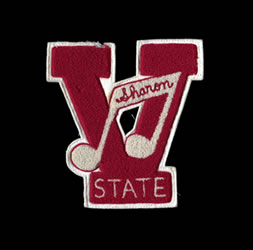
VARSITY LETTER OF SONG LEADER SHARON HAAS SMITH, WHO ATTENDED SFVSC IN THE EARLY 1960s AND GRADUATED FROM CSUN IN 1977.
Homecoming
In the early days of the Associated Students, women students organized a separate affiliated group - Associated Women Students - in charge of homecoming and special student events. The Homecoming Committee for 1964 was responsible for the selection of Queen candidates and Claim Jumpers celebrations, including: carnival rides, bonfire and rally, an informal dance at Devonshire Downs, the coronation ball held at the Riviera Country Club, float building, the homecoming parade, and closing events after the football game at the Matador stadium.
1963 Homecoming Queen Michele Stickel and her court: Cheri Durocher, Lynne Hays, Jerilyns Russell, and Linda Sadowsky. Sunburst Yearbook, 1964.
Judge Julian Beck and Dr. and Mrs. Ralph Prator drive past reviewing stand in the homecoming parade, ca. 1960.
The Granny Girls Organization was first formed in 1966 by Dottie Heitz and fifteen Valley State students, to provide hostesses at sporting and homecoming events and to promote a spirit of friendship and camaraderie on the campus. By 1969 there were thirty members that met at their favorite campus hangout "The TUB" (Temporary Union Building) to party and plan activities. The University honored Dorothea Heitz for her contributions by establishing the Heitz Award for Outstanding Volunteer Leadership. [Courtesy of Alumni Relations who donated the Granny Heitz Memorabilia to the University Archives]
Lambda Chi Alpha entry in the 1987 Homecoming parade commemorating the United Nations.
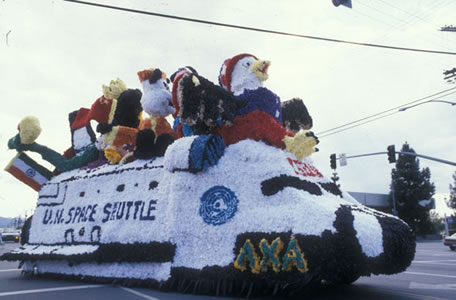
Early Days · Rapid Growth · Campus Life · CSUN in the Community · CSUN in the World

![SUNRISE – STUDENT HANDBOOK, SFVSC, [1958]](images/campus_life/RG03-01ms002-small.jpg)
